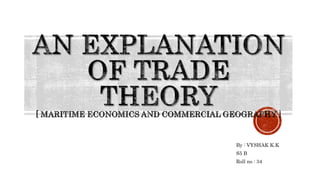
Gains from Trade Theory and International Trade Patterns
- 1. By : VYSHAK K.K S5 B Roll no : 34
- 2. We have shown empirically that the most important single cause of trade growth is GNP, but these are just statistical relationships. Every economist is taught that statistical relationships can change. It would be reassuring to know why trade increases with GNP and, more importantly, the circumstances under which this important relationship might break down. To answer these questions we must turn to trade theory.
- 3. If countries do not believe that trade is in their interest they can close their borders. China, the USSR, and Japan have all followed this policy in recent history. A policy of not trading, or limiting trade by tariffs or quotas, is known as ‘protectionism’, or in its extreme form ‘isolationism’. It seeks to exclude the goods produced by foreigners from local markets in order to protect the livelihood of local producers. It seeks to exclude the goods produced by foreigners from local markets in order to protect the livelihood of local producers. Protectionism can look very attractive to a community which feels that its livelihood is under threat. Reason for adopting these policies is to protect local resources ; 1. It may seem that valuable raw materials are being exported by unprincipled traders, leaving nothing for the local inhabitants. When the reserves are all gone, the country will be left in poverty. 2. Another is to protect local jobs and skills which have been developed over many years.
- 4. Three hundred years ago David Hume addressed this question in his Discourse on the Balance of Trade (1752) (see Meek, 1973). Hume did not think much of this line of protectionism, commenting: It is very usual in nations ignorant of the nature of commerce, to prohibit the exportation of commodities, and to preserve among themselves whatever they think valuable and useful… There still prevails, even in nations well acquainted with commerce, a strong jealousy with regard to the balance of trade, and a fear, that gold and silver may be leaving them
- 5. The first step in developing a proof that trade is beneficial was made by Adam Smith and is referred to as the ‘theory of absolute advantage’. He argued that countries are better off if they specialize, trading their surplus production for the other goods they need. Specialization allows them to become more productive and everyone benefits because the world’s limited economic resources (factors of production) are used more efficiently
- 6. The Theory of Comparative Advantage, published by David Ricardo in 1817, demonstrated that this was not the case. He proved that trade is beneficial, even if one country is more efficient than its trading partners at producing all goods. If we rerun the example, but make the US better at producing both food and cloth, the countries are still richer with trade than without. The heart of the theory is that provided each country is more efficient at producing some goods than others, trade will be beneficial if each country specializes in the products at which it is relatively most efficient. More wealth is created by trade because limited ‘factors of production’ are used more efficiently and all participants are better off than they would be without trade. This has important implications for trade
- 8. One of the most important causes of trade from the shipping industry’s point of view is the fact that different countries with different natural resources. The importance of resources was first recognized by trade economists who were looking for an explanation of what determines the comparative advantage of a country. This was an issue which Ricardo did not address and it was more than a century before that economists came up with a theoretical explanation. The key issue turned out to be the assumption of constant costs, which is one of the basic building blocks of Ricardo’s model The theory of comparative advantage assumes that resources can be freely switched between the manufacture of different products without any loss of productivity. Even in the abstract world of economic theory this is clearly not realistic. In the 1920s two Swedish economists, Eli Heckscher and Bent Ohlin, concluded that productivity differences occur because countries have different endowments of factors of production, and there is limited factor substitution.
- 9. All we need for trade to be beneficial is that economic resources are unevenly distributed between countries. Winters(1991)summarizes these minimum conditions as follows: 1. The production functions for the two products give constant returns to scale if both factors are applied proportionally, but diminishing returns to any individual factor (i.e. if a country runs out of land, but keeps applying more labour, fertilizers, machinery, etc., marginal returns fall). 2. Goods differ in their requirements of different factor inputs (e.g. food production needs more land than textile manufacture). 3. The countries have different relative factor endowments.
- 10. A very different reason for trade is technical innovation. Manufactured goods often require specialist investment and expertise. Once a particular company or country has become established in this area, it is difficult for others to build up sufficient volume of sales to break into that market. In the nineteenth century Britain developed mechanized textile manufacturing, and for some years gained a great benefit from this.
- 11. Anyone studying trade statistics will soon notice another type of trade, called inter- industry trade where countries import and export the same products. Motor cars are a classic example, but petroleum products, electronic equipment and a whole range of consumer goods also qualify. In these cases the cause of trade is usually differences in tastes between countries